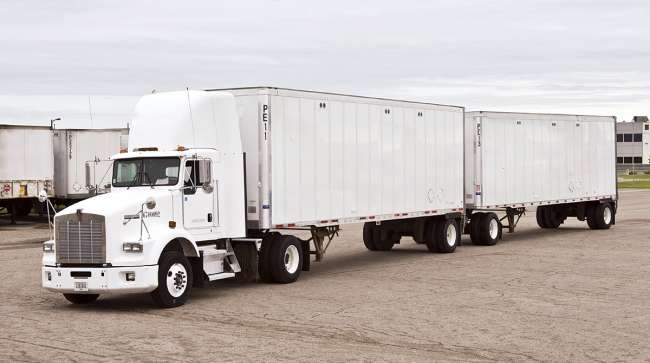Senior Reporter
TRB Truck Size and Weight Panel Faces Political Headwinds Over Heavier, Larger Trucks

WASHINGTON — Members of the Transportation Research Board’s Truck Size and Weight Committee said they continue to face stiff headwinds to garner public and political support for heavier and longer trucks, despite evidence that demonstrates the potential for reducing carbon emissions and increasing cargo efficiency.
“If you look at things like engine development, drive-line improvement, rolling resistance tires, aerodynamics — none of those things can compare to improved efficiency in their carbon capacity,” John Woodrooffe, outgoing chairman of the committee, said at a Jan. 15 session at TRB’s annual meeting here. “I think the U.S. is terrifically placed to make enormous gains here, simply because we have not moved in our size and weight since 1982. The rest of the world, of course, has.”
Woodrooffe added, “You could look at the rest of the world as being the crucible of improving the concept and going forth with the policy. So it’s not as if you have to, in the U.S., initiate new policy concepts.”
Incoming committee chairman Michael Onder, president of Burke, Va.-based C3 Consulting, said he plans to promote research and expand collaboration with state and federal agencies for greater understanding of how truck size and weight regulations and technology can influence transport efficiency and safety and reduce carbon emissions.
Woodrooffe added, “The science is overwhelming. It used to be uncertain. But now it’s well-understood.”
However, a two-year comprehensive truck size and weight study mandated by Congress in 2015 and carried out by the Federal Highway Administration studied an array of truck configurations but did little to advance the case for Congress to change current truck weight limits. In some ways, FHWA concluded that the study was so packed with incomplete data that it yielded more questions than it sought to answer.
Peter Rogoff, former undersecretary for policy at the U.S. Department of Transportation, told congressional leaders at the time that data collected were so limited that DOT could not recommend any changes to current federal policy. Rogoff said the research “revealed very significant data limitations that severely hampered FHWA’s efforts to conclusively study the effects of the size and weight of various truck configurations.”
The study also showed that all six truck configurations studied likely would result in a decline in fuel costs and carbon dioxide and nitrogen oxide emissions.
Jeff Purdy, a committee member and FHWA transportation specialist, said his agency is keeping an eye on two trucking companies in Florida using one configuration not studied in 2015, twin 33-foot trailers. He called it a “narrow synthesis” and not a study.
“Back when we did the comprehensive truck size and weight study there weren’t any twin 33s in use,” Purdy said. “Since that time there’s been two companies that have been using them. We wanted to look at what their experience was and see if that would change any of the conclusions that were made in the original truck size and weight study.”
Purdy declined to name the two companies, but said they are running their twin 33s on Florida interstates.
Purdy added, “There’s not going to be any kind of recommendation that comes out, in terms of whether Congress should look at them.”
The committee briefly discussed the current state of truck platooning, keying off of a recent decision by Daimler Trucks that the truck maker has not been able to achieve expected fuel savings in real-world tests of truck platooning and would not prioritize the technology going forward.
Much of the platoon testing has been conducted using three trucks. But committee member Luke Loy, a mechanical engineer for the Federal Motor Carrier Safety Administration, noted that testing by Transport Canada was achieving better results involving only platooning two trucks.
“Scania is looking at platooning doubles,” Loy said. “That seems to be a better answer.”
American Transportation Research Institute Vice President Dan Murray noted that trucks hauling hazardous materials and certain commodities, and those using some technologies, cannot platoon.
“The universe is small,” Murray said. “So don’t move your 401(k) into platooning yet.”
But Woodrooffe suggested that committee members remain open-minded about platooning.
“There may be times that platooning can work, and times when long vehicles can work,” he said.




